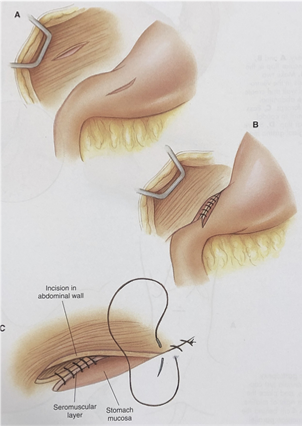Client Resources
Gastric Dilation-Volvulus (GDV) & Gastropexy

Gastric Dilation-Volvulus is a condition where the stomach twists on itself and fills with gas. It is also known as “bloat,” “stomach torsion” or “twisted stomach”. GDV is a life-threatening condition that is considered an emergency if suspected or diagnosed.
GDV is most commonly seen in medium and large breed dogs with deep chests such as Great Danes, German Shepherds, Greyhounds, Dobermans, Weimeraners and Dalmatians.


There are several factors that contribute to the occurrence of GDV, but its direct cause has not been clearly identified. Conformation plays a role and the dogs with deep and narrow chests are more commonly affected. Dogs that are fed a single large meal per day also seem to be more commonly affected. The risk of GDV increases with age, with dogs over 7 years of age approximately twice as likely to develop GDV when compared to dogs 2-4 years old. There is some speculation that vigorous activity and exercise shortly following a meal can increase the risk of GDV.
Given the right set of circumstances, the stomach can dilate with gas that is swallowed during eating. The dilated stomach can then more easily rotate on itself, cutting off the in- and out-flow of the stomach, and more importantly, its blood supply. This interruption to blood supply has a series of life-threatening consequences such as shock, breathing difficulties, heart arrhythmias, stomach wall breakdown, and sepsis.
Dogs with GDV may initially show signs of abdominal pain, such as stretching, turning to look or bite at their abdomen, or stand with their back hunched. They often start to retch and try to vomit but don’t bring anything up. Their abdomen will start to appear distended. They often become lethargic and weak, and their gums may start to look pale.
Signs of GDV often appear suddenly and progress quickly over a couple of hours
Definitive diagnosis of GDV is made by an abdominal x-ray. A GDV has a very typical appearance of a large, gas filled stomach that forms a “smurf hat” or “boxing glove” shape. Often our suspicions are raised based on breed, clinical history from the owner (sudden onset of signs and rapid decline), and physical exam, but the x-ray is required for us to be sure.

Immediate emergency treatment involves giving rapid intravenous fluids for circulation support and pain relief. This is often started before or at the time of abdominal x-rays. Once the diagnosis is confirmed, we then consider surgical options. The stomach must be relieved of the gas pressure, either by passing a tube through the mouth to the stomach, or by using a needle through the abdominal wall into the stomach. Once the initial pressure is relieved then the animal is prepared for an anaesthetic and surgery. Often blood tests are performed to determine their electrolyte balance as well as overall organ health. Surgery involves untwisting the stomach, assessing the health of the stomach wall, resecting any portions that are not able to be saved, and then performing a gastropexy to prevent the stomach from twisting again.
Anaesthesia and surgery in these patients carries a high level of risks and can be very costly.
Some patients do not survive their procedure, often due to poor circulation, electrolyte changes, heart arrhythmias, and toxins released into their blood stream. There is still a high risk period for up to 2 weeks after surgery. During this period, they can suffer from kidney damage, ongoing electrolyte imbalances, heart arrhythmias, and the stomach wall can break down further. Intensive care and monitoring is recommended 24 hours a day during the first few days of recovery.
Some owners elect not to proceed with surgery based on the risks or costs involved, at which point euthanasia is the only other recommended option.
As mentioned earlier, a gastropexy can be performed at the time of surgery, to prevent the stomach from twisting on itself again later. However, a gastropexy can be performed as a preventative in a healthy dog that is considered at risk.
The stomach has two tissue layers that make up the stomach wall. Gastropexy involves suturing the outer layer of the stomach to the internal abdominal wall, so that the stomach is pinned in position again the abdominal wall. The sutures will form a scar and adhesion, and help to prevent the stomach from being able to completely twist on itself. The stomach should be able to expand and contract as normal during digestion, and should not cause any discomfort on-going for the dog.

A gastropexy will reduce the risk of a GDV by 80% or more, and carries low risk when performed as a preventative or prophylactic measure in a healthy dog.
Often a prophylactic gastropexy is performed at the time of desexing in at-risk breeds between 6 and 12 months of age. Performing a gastropexy at this time reduces the risk to the patient as only one anaesthetic is performed (rather than two procedures), and therefore reduces the cost involved. However, if the dog is not going to be desexed, then a prophylactic gastropexy can be performed on its own.
A prophylactic gastropexy can save your dog from developing GDV and save its life, and save you the costs involved in treatment for GDV.

